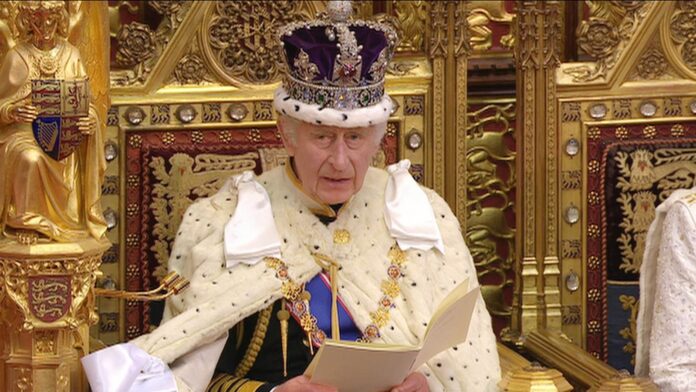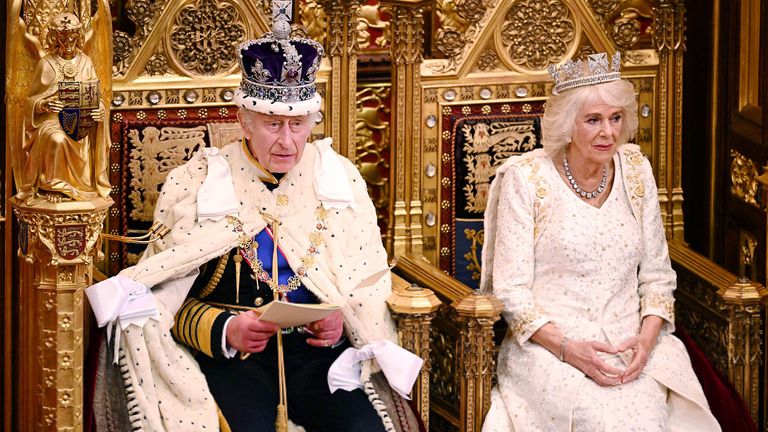A new era in parliament begins today with the King’s Speech, giving us the chance to see some of the country’s long-standing traditions.
The speech is part of the State Opening of Parliament, which marks the formal start of the parliamentary calendar and brings together the monarchy, the House of Lords and the House of Commons for a bit of pomp and ceremony.
It may feel like a fresh start but this ceremony is filled with rituals that go back over 500 years.
But what is the King’s Speech for, what should we expect to see and what quirky traditions are included?
From doors being slammed to bomb checks, here’s what you need to know.
What is the King’s Speech for?
Although it’s the monarch who delivers the speech, it’s the government that writes it, with the aim of outlining its policies and proposed legislation for the new parliamentary session.
While a parliament – meaning the period of time between general elections – can last for up to five years, a new parliamentary session is normally launched annually.
The last one, which the King delivered for Rishi Sunak’s government, took place in November last year, but we now have another one to mark the new Labour government’s agenda.
Although it’s a formal-feeling affair, there isn’t anything legally binding about the speech. It can outline bills that never actually become law, and bills can also be passed by the government later that weren’t included in the speech.
Rather, the speech is essentially a giant press release for the government to outline its agenda clearly – and it gives its opposition the chance to criticise it.
How will the day play out?
The King will leave Buckingham Palace in his state coach late morning, making his way to the Houses of Parliament in a procession led by the Household Cavalry, which consists of the two most senior regiments in the British Army: The Life Guards and The Blues & Royals.
He’ll arrive at the Sovereign’s Entrance at around 11.20am, before heading to the Robing Room to put on the Imperial State Crown and ceremonial robes.
The King will then lead the Royal Procession through the Royal Gallery to the chamber of the House of Lords before taking his seat on the throne, where he’ll deliver his speech from around 11.30am.
While there’s no set time for the speech’s duration, outlining a government’s agenda can be time consuming. The King’s last speech in November clocked in at about 11 minutes 30 seconds and consisted of 1,223 words, making it the longest by a monarch at a State Opening of Parliament since 2005.
Once the King’s Speech concludes, a new parliamentary session will begin, with MPs debating its contents around two hours later in the Commons.
Debates over the speech typically continue for several days, before it’s voted in by the Commons. The vote is largely symbolic, and no government has lost it for 100 years.
The debate has already been added to the parliamentary diary until Tuesday 23 July.
What traditions can you expect to see?
There will be a few moments that you don’t see every day in parliament, one of the most well-known being the Black Rod’s role.
After taking to his throne, the King will signal for the House of Lords official to summon MPs from the House of Commons.
Black Rod obliges, only for the Commons door to be slammed in their face upon arrival. This tradition, which dates back to the Civil War, is used to symbolise the Commons’ independence from the monarchy.
Black Rod bangs on the door three times with their rod before it is opened and then all MPs follow them back to the Lords to hear the speech.
This tradition was born from the monarch’s clashes with parliament centuries ago, particularly under the rule of King Charles I, who was beheaded in 1649 at the conclusion of a civil war caused by the tensions.
Once the members are in and the King is ready to speak, you’ll see the Lord Chancellor get down on a bended knee in front of him to present the monarch with the speech, carried in a special silk bag.
As well as the King wearing his crown and robes, you’ll see members of the House of Lords wearing traditional parliamentary robes.
Earlier in the day, you’ll also see the mace – a parliamentary symbol of royal authority – be transported to parliament in a separate carriage. Tradition dictates that without the mace, a silver gilt ornamental club of about five feet in length, neither house can meet or pass laws.
Bomb checks and hostage taking
Two of the most bizarre traditions take place behind the scenes of a State Opening.
Before the monarch arrives at parliament, the Yeomen of the Guard, the royal bodyguards, carry out a search of the cellars of the Palace of Westminster for explosives.
It’s a ceremonial search dating back to the King’s Speech in 1605.
Read more:
What we can expect from the new government’s first 100 days
What is the NATO summit and why is Sir Keir Starmer going?
Then monarch King James I, a Protestant, had cause for concern in the aftermath of the Guy Fawkes gunpowder plot – a failed attempt by English Catholics to blow up both him and parliament.
Another tradition to assure the monarch’s safety was introduced in 1649 and sees a Member of the Commons “taken hostage” in Buckingham Palace while the King or Queen attends Westminster.
This again relates to when the monarch and parliament’s relationship was more fractured, meaning the King wanted assurances that he wouldn’t be harmed while in Westminster.
The hostage is usually a government whip. Last year it was Jo Churchill, former MP for Bury St Edmunds and Vice Chamberlain of HM Household.
Speaking in a video on X shortly after the speech, she said: “I had an interesting role here in today’s proceedings. So you may have seen that somebody gets taken hostage – that was me.
“So I am whisked away, up to Buckingham Palace, while the King is here in parliament, delivering the speech to both houses. Now luckily, I’ve been sent back.”
What do we know about the contents of this speech?
More than 35 bills are expected to be unveiled by the King.
Labour said the focus would be on “unlocking growth and improving living standards for working people” in what it called an “ambitious legislative agenda”, echoing the “first steps” Sir Keir Starmer campaigned on in the general election.
It is not clear yet what all the bills will be, but Downing Street confirmed a number of measures on the eve of the speech.
They include legislation to bring rail services back into public ownership when their current private contracts expire and the establishment of a new public body called Great British Railways to oversee both the services themselves and fares.
A Better Buses Bill will also be introduced, giving local authorities more power to franchise their services, as well as lifting restrictions on creating new publicly owned bus operators.
Long-trailed planning reforms are expected to be outlined to help with the building of houses and infrastructure, and a new English Devolution Bill will transfer further powers to local leaders.







